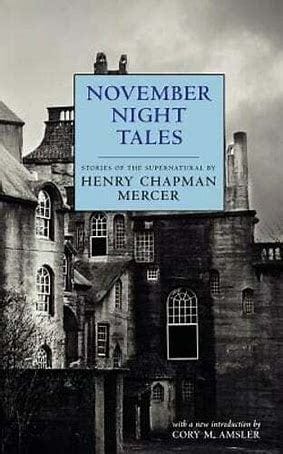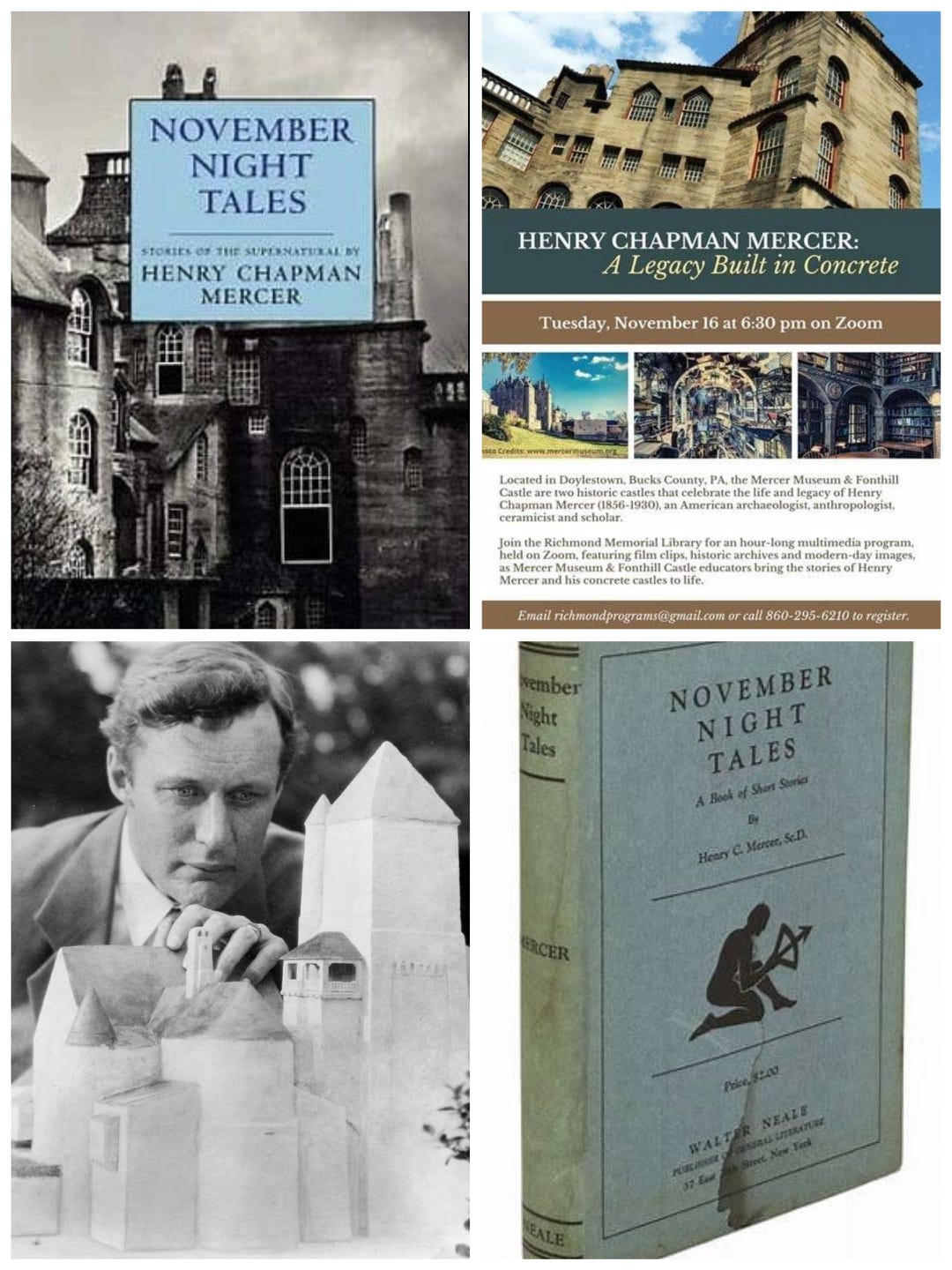Readers unfamiliar with November Night Tales may prefer to read these notes only after reading the collection.
The title
November in Mercer's semi-rural Eastern Pennsylvania, like my region of semi-rural Ohio, is a time of bare branches, brown fields, icy mud and overcast skies. Birds are on the wing and hunters set traps in cold streams. Nights in November begin early: chores are done by 4:30 p.m., with livestock fed, watered, and in for the night.
Alas, late autumn tale-spinning is a forgotten art. My grandmother had a few from her Michigan girlhood, but moved to a working Ohio farm as a newlywed adult. Family yarning quickly dries-up without a mix of generations in the house.
Henry Chapman Mercer's title November Night Tales (1928) is best viewed as ironic stage-dressing. None of the tales take place in November. However, many feature action at night, or in the gloaming. In one, an earthquake turns day into night as a city lost beneath the Adriatic for two millennia rises temporarily to the surface. “The Blackbirds” features a Midsummer Night search by two men for their vanished friend, gone missing on his birthday when, against the advice of fortune tellers, he went sketching.
Mercer packs plenty of beguiling weirdness into November Night Tales. His depiction of U. S. and European landscapes and seasons, and the strange hours “‘twixt dog and wolf,” will be enjoyed by horror fiction readers.
* * *
The tales
"Castle Valley" (1928) takes place in semi-rural eastern Pennsylvania in the 1880s. Two young men are united by both friendship and experiences in a literal uncanny valley where futures might be assured. A scrying stone, a local pow wow doctor, and a motto from Virgil all play their parts.
* * *
"The North Ferry Bridge" (1928) is the first-person narrative of a young doctor in a semi-rural practice with no budget for a horse and buggy. The story begins quaintly, and the reader might be expecting a pastel of gently observed local color, like "Castle Valley." But far from it. The doctor quickly finds himself in the crosshairs of an escaped madman scientist with an army of cholera-infected albino rats.
* * *
"The Blackbirds" (1928) begins with the easeful table talk of two friends, Carrington and Norton, about their superstitious friend, artist William Pryor. Carrington and Norton are embarking on a walk this sunny Midsummer Eve, and Pryor soon joins them. Their route will take them by abandoned quarry escarpments in the thickly forested and disorienting terrain near Deadlock Meadow. The day's modest pleasures end when they are separated from Pryor. During a confused search, Carrington and Norton watch as the sky fills with crows. From this point, "The Blackbirds" becomes a distanced manhunt mystery. Carrington and Norton attend a vacationing anthropologist, Professor Blackmore, who blames a cult of immigrant Parsees for Pryor's disappearance. The local police chief blames resurrection men. Mercer beautifully evokes the midsummer atmosphere: smoky table lamps, summer beetles, swarms of late night fireflies, breakfast tables piled with empty dishes, men lounging in embroidered dressing gowns, and the perils of walking on railroad trestles. A world -- Mercer tells us -- "too gay for phantasms." Gay or not, Pryor's strange Midsummer adventure -- clocked by friends at the mercy of secondhand facts and explanations -- evokes a sprightly world of bourgeois rustication long ago gone with the wind.
* * *
"The Wolf Book" (1928)
✂ summer
✂ antiquarian book-buying trip
✂ Danube ✂ houseboat
✂ Vienna coffee and kümmelbrot
✂ Carpathians ✂ Hungary
✂ professor and servant
✂ premonitory dreams
✂ monastery
✂ hidden manuscript
✂ Baron Trenck
✂ gypsy brigands
✂ peripeteias: bad to worse to worst
✂ amputations
✂ Borobassa: a village with no dogs or children:
A close, sickening smell met them as they entered a room faintly lit by the fading window-light and a grease-lamp flickering on a shelf. They saw a garret, a step-ladder, some kettles on a bench, and around the walls, or hanging from the rafters, dark masses of clothing and shoes. Some of the shoes were of child’s size....
Where has "The Wolf Book" been hiding from readers for the passion for antiquarian horror stories? A superb novella, it checks all the boxes:
* * *
With "The Wolf Book," Spencer made a supernatural thriller set in a lycanthrope-ridden region of the Hapsburg Empire, where a lost/ recovered manuscript could still draw scent-tracking villains and place a touring antiquarian scholar in peril at each frontier, ruin, or village where he stopped.
"The Dolls' Castle" (1928) returns us to urban 1880s eastern Pennsylvania. Dramatist and one-time lawyer Carrington, last encountered in "The Blackbirds," here plunges into a haunted house mystery as he seeks colorful settings for a stage melodrama.
"The Dolls Castle" unfolds in discrete episodes over several years. At each stage, stakes for investigation and resolution of the haunting increase, expanding to involve more friends attracted by Carrington's efforts.
Uncertainties accumulate. What is the actual location of the house, its street name and house number? And which description of the specter's appearance is accurate? All these points become less definite the more Carrington probes witnesses and the evidence of his own senses.
"The Doll's Castle" has nothing to do with haunted dolls or doll houses. However, there is for much of the story the flavor of Lord Lytton's "The Haunted and the Haunters; or, The House and the Brain" (1859), as Carrington himself acknowledges. The climax has the raw impact of Lucy Clifford's "The New Mother" (1882) and, especially, Bithia Mary Croker's sublime masterpiece, "The Red Bungalow" (1919).
* * *
[....] Imagine his pretending to predict how and when this jack-o’-lantern city should rise from the sea.” The priest had followed me across the floor of the great library to the outer passage.
“The worst of it is,” he added, as I took my leave, “that he is so certain of the event,—the earthquake,—that he dates it for next month, says he has given up his apartments, and ordered the removal of his collection to a place of safety. Of course, with his public influence, this kind of talk may end in a stampede of the inhabitants,—perhaps a riot.”
Set on the Adriatic coast in the 1880s, "The Sunken City" is an ambitious archaeological adventure. Its final chapter features enough catastrophe to satisfy devotees of John Wyndham and John Christopher. Spencer conveys the sun-struck landscape with hypnagogic clarity.
* * *
"The Well of Monte Corbo" (1930)
“I am sorry,” said I, “that my friend got off without telling you a curious story about this castle. Did you ever hear that Durer while escaping there from some robbers, threw a church relic of some sort for safety into a well?”
A politely repressed laugh met my question.
“Doctor Lysander’s treasure story. A church legend foolishly mixed up with his Durer letters and passed on to your friend.” The curator paused, and then in a somewhat stern voice continued: “But we have heard too much of these letters. They have been discredited by half a dozen critics, notably by Professor Winters, the well known Durer scholar. I haven’t followed the controversy, but someone has paid dearly for a patchwork of genuine fragments and forgeries, with an authentic signature.”
“You don’t suspect the Doctor, I hope,” said I.
Mercer does enjoy robbers and brigands. A thug helps out a mad scientist in "The North Ferry Bridge." There are lycanthropic gypsy thieves galore in "The Wolf Book." And archaeologists turn to brigandage when an earthquake raises "The Sunken City" in the Adriatic.
"The Well of Monte Corbo" is an adventure of ratiocination. Thirteenth century castle and mountain drawings allow Mercer's narrator and the narrator's comrade Theodoric Barron to locate -- after a number of red herrings -- the ruins and the well.
Will scholarly detective work be enough to vindicate grandiose scholar Dr. Lysander and restore his reputation?
“Let the dogs bark,” [Lysander] cried, turning upon us with a contemptuous sweep of the powerful arm. “The caravan moves on.”
Barron smiled, and then shook his head. “Too bad,” said he, after the resounding footsteps had died away outside. “A man you can’t advise, much less contradict. This is the third or fourth of his notorious wrangles, all the more deplorable when they end in reversions to his old duelling habits at Jena. Did you notice the face-scars?”
“He doesn’t look like a man to be trifled with,” said I. “But do you believe all this?”
“Not half of it,” laughed Barron. “The Doctor has exaggerated the meaning of his letters, which show that Durer has been impressed with a church legend, nothing more. Your castle in the air has nothing to do with it. Durer was not a realist. To my mind the whole landscape you have sketched is imaginary, as far off the earth as the cloud that floats over it.”
* * *
Contexts: 1928 and all that
November Night Tales is the collection I most enjoyed reading in 2023.
ISFDB and publisher Valancourt give 1928 as the publication year for November Night Tales.
Other noteworthy collections published in 1928:
They Return at Evening by H. Russell Wakefield
The Runagates Club by John Buchan
The Silver Thorn: A Book of Stories by Hugh Walpole
Spook Stories by E. F. Benson
Etched in Moonlight by James Stephens
Mist and Other Stories by Richmal Crompton
Individual short stories of note from 1928:
"Johnny Double" by Arthur Machen
"The Ankardyne Pew" by William Fryer Harvey
"Wailing Well" by M. R. James
"The Call of Cthulhu" by H. P. Lovecraft
"The Lurking Fear" by H. P. Lovecraft
* * *
A matter of opinion
The Weird and the Wonderful YouTube channel featured November Night Tales in a 2019 episode. I disagree with the commentator’s assessment that Mercer's stories are written in the manner of M. R. James and L. T. C. Rolt. While several of the stories are antiquarian in their plot material, only a couple feature the supernatural. Of these, the strongest – and a very fine supernatural horror story – is “The Doll’s Castle.” But it has more in common with heartbreakers written by E. Nesbit, B. M. Croker, and E. F. Benson than James’ droll nightmares.
November Night Tales is a superb collection of robust adventure stories, each tinged with the weird and uncanny. It's a collection to savor.
Jay
28 November 2023








Thanks, Jay. Here is another writer I've never encountered that I must seek out.
nice review. i’d not heard of him before